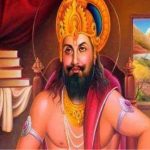In the Rigveda (2:27:1) Daksha (ritual skill) was one of the six adityas, deities related so closely to Vedic sacrificial ritual that they may be called personifications of its logic and method. During the Vedic period the six expanded to twelve, with Daksha always among the most important. Ritual skill in sacrificial magic-science was then central to Vedic and Brahmanical religion and mythology.
In the great Hindu epics, references to Daksha abound, as numerous versions of his myth were recorded without much regard for consistency. Daksha was born from the right thumb of Brahma, or had his origin with the six or seven maharishis or with the eight prajapatis, or was even one of the mind-born of Brahma. His fluid nature ranged from being father of energies like Garuda (the sun bird) to being father of some minor demons. The idea of Daksha’s sacrifice began in the epics. Daksha, whose very name must be associated with sacrificial ritual, presided over a sacrifice in which Siva misbehaved by kicking out the teeth of the god Pushan (the nourisher and protector of cattle), put out the eyes of the god Bhaga (inheritance), and broke the arms of the solar god Savitri (vivifier).
In the Puranas the myths reached a point where there were either two separate Dakshas or Daksha’s life must be interpreted in two cycles—one as a prajapati and another as a rebirth as the Daksha who would not invite Siva to his sacrifice. In his role as Prajapati, following the account in the Vishnu Purana, Daksha was ordered by Brahma to create all the subjects (prajas). So Daksha created devas, sages, gandharvas, asuras, nagas, and so on. Turning these out one at a time was not efficient. So he invented coition and produced with his wife Asikni five thousand sons, the Haryashvas. However, Narada—a sage whose Puranic role was to make trouble or to tell secrets—sent the Haryashvas to learnthe wonders of the world, and they never came back. Again Daksha and Asikni went back to work and created a new race—a thousand Sabalasvas. And once again Narada sent them to the ends of the earth, and they too were lost. Daksha angrily cursed Narada to be a homeless wanderer (and all know this curse as the reason why Narada was always available for a grand entrance into any myth). Then wise Daksha created by coition sixty daughters, giving them as wives to the gods and lesser prajapatis: ten to Dharma, thirteen to Kasyapa, twenty-seven to Soma (or Candra, the moon), four to Arishthanemi, two to Angiras, and two to Krishashva. Daksha had twenty-four more daughters by Prasuti, one of whom, Sita, he gave to Siva and another to Bhrigu, his father in the Epics but now his son-in-law. At this point the Puranic mythmakers chose to end the myth of the venerable and wise Prajapati Daksha or to re-introduce him in another lifetime in a Saiva myth cycle.
In the Siva Purana Daksha became a very negative figure who tried to humiliate the Absolute, which in this Purana was Siva. Daksha objected to his daughter Sati’s relationship with Siva. Even though it was assumed that Sati was already Siva’s wife, there was a noteworthy omission of a proper wedding. Such a wedding would have legitimated Siva ritually and would have made Daksha’s objection to Siva’s presence at an orthodox sacrifice to the gods without meaning. This myth addressed something that has had currency even in the modern period: that Siva and his cult were not Vedic and his presence would pollute Daksha’s ritual. Most accounts present Siva as being unconcerned about not receiving an invitation, but everything changed because of what happened when Sati went alone—against Siva’s advice. Daksha’s later Puranic persona behaved badly, humiliating Sati so totally that she threw herself into the sacrificial fire, turning it into a funeral pyre, and becoming an example of a woman’s ultimate sacrifice (sati), the self-immolation of a wife, who thereby becomes a model of purity). Sati became a sati (“a pure one” feminine) by committing sati.
Siva became outraged. From his anger two demonic figures were created, Virabhadra and Bhadra-Kali, and they killed Daksha and destroyed his sacrifice. But what Siva won in this myth by brute force, he also lost: he was the causal agent in the killing of the brahmin Daksha. And non-Shaiva myths added this sin to other reasons Siva and his cult were less Vedic and less orthodox.
This myth was important devotionally, however, as it taught that devotion to Siva was more important than sacrifices or rituals performed without devotion.

